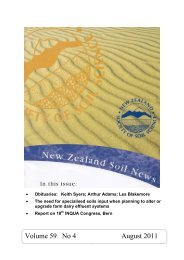Download - New Zealand Society of Soil Science
Download - New Zealand Society of Soil Science
Download - New Zealand Society of Soil Science
Create successful ePaper yourself
Turn your PDF publications into a flip-book with our unique Google optimized e-Paper software.
tephras, erupted before ca 18,000 cal. yr BP, were dated by calibrating limited numbers <strong>of</strong> 14 C ages<br />
using IntCal04 (Okareka) or comparison curves <strong>of</strong> the expanded Cariaco Basin sequence (Te Rere,<br />
Kawakawa/Oruanui, Poihipi, Okaia). Kawakawa/Oruanui tephra, the most widely distributed marker<br />
tephra, was erupted probably ca 27,097 ± 957 cal. yr BP. Potential dating approaches for the older<br />
tephras include their identification in Antarctic ice cores (if present) or annually laminated sediments<br />
for which robust calendar-age models have been constructed, high-precision AMS 14 C dating on<br />
appropriate material from environmentally stable sites, systematic luminescence dating, or new<br />
radiometric techniques (e.g. U-Th/He) if suitable minerals are available and errors markedly reduced.<br />
Further application <strong>of</strong> Bayesian age-modelling to stratigraphic sequences <strong>of</strong> 14 C ages, possibly<br />
augmented with luminescence ages, may help refine age models for pre-Holocene tephras with the<br />
largest errors. Finally, we discuss the critical role these marker tephras play in the ongoing<br />
construction <strong>of</strong> an event stratigraphy for the <strong>New</strong> <strong>Zealand</strong> region, which is a key objective <strong>of</strong><br />
Australasian and Southern Hemisphere INTIMATE projects.<br />
Source: Quaternary <strong>Science</strong> Reviews (2008) 27: 95-126.<br />
_______________________<br />
Selected abstracts from the <strong>New</strong> <strong>Zealand</strong> Trace elements Group Conference 2008, WEL Energy<br />
Trust Academy <strong>of</strong> Performing Arts, University <strong>of</strong> Waikato, Hamilton, <strong>New</strong> <strong>Zealand</strong>; 13-15<br />
February 2008.<br />
Copper and zinc in soils: Too little or too much?<br />
Brian J. Alloway<br />
Dept <strong>of</strong> <strong>Soil</strong> <strong>Science</strong>, School <strong>of</strong> Human and Environmental <strong>Science</strong>s, University <strong>of</strong> Reading, UK<br />
Copper and zinc are essential for the normal healthy growth <strong>of</strong> plants (and animals/humans). When the<br />
available concentration <strong>of</strong> either element in the soil is too low, plants suffer from deficiency and when<br />
it is too high, toxicity will occur, at least in the more sensitive organisms. Ideally, the available<br />
concentrations should be in the window <strong>of</strong> essentiality between the two extremes.<br />
Background concentrations <strong>of</strong> copper and zinc in selected countries and the critical concentrations<br />
used in the interpretation <strong>of</strong> soil test extractions will be considered. Brief mention will be made <strong>of</strong> the<br />
essential functions <strong>of</strong> copper and zinc in plants, the soil and plant factors affecting bioavailability and<br />
examples <strong>of</strong> the effects <strong>of</strong> deficiencies <strong>of</strong> on crop yield and quality. The main sources <strong>of</strong> copper and<br />
zinc contamination will also be covered, together with typical soil concentrations encountered at<br />
different types <strong>of</strong> contaminated sites. The upper critical concentrations (PNEC, NOAEL etc) adopted<br />
in different countries to protect soil organisms and processes will be compared and the risks to soil<br />
fertility discussed.<br />
The key themes emerging from these considerations <strong>of</strong> copper and zinc in soils are:<br />
Low available concentrations can reduce crop yields and quality without the appearance <strong>of</strong> obvious<br />
symptoms (hidden deficiencies).<br />
Existing upper limit values are helpful for protecting soils from toxic accumulations, but need to be<br />
tailored to local soils, environmental conditions and land management.<br />
Intensive livestock production and fungicidal formulations are the main sources, except where sewage<br />
sludge is applied to land or zinc fertilisers are used on a regular basis.<br />
77










